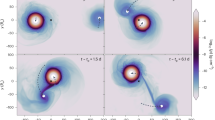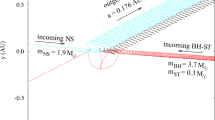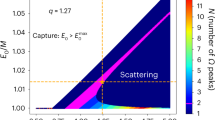Abstract
The tidal disruption of a solar-mass star around a supermassive black hole has been extensively studied analytically1,2 and numerically3. In these events, the star develops into an elongated banana-shaped structure. After completing an eccentric orbit, the bound debris falls into the black hole, forming an accretion disk and emitting radiation4,5,6. The same process may occur on planetary scales if a minor body passes too close to its star. In the Solar System, comets fall directly into our Sun7 or onto planets8. If the star is a compact object, the minor body can become tidally disrupted. Indeed, one of the first mechanisms invoked to produce strong gamma-ray emission involved accretion of comets onto neutron stars in our Galaxy9. Here we report that the peculiarities of the ‘Christmas’ gamma-ray burst (GRB 101225A10) can be explained by a tidal disruption event of a minor body around an isolated Galactic neutron star. This would indicate either that minor bodies can be captured by compact stellar remnants more frequently than occurs in the Solar System or that minor-body formation is relatively easy around millisecond radio pulsars. A peculiar supernova associated with a gamma-ray burst provides an alternative explanation11.
This is a preview of subscription content, access via your institution
Access options
Subscribe to this journal
Receive 51 print issues and online access
$199.00 per year
only $3.90 per issue
Buy this article
- Purchase on Springer Link
- Instant access to full article PDF
Prices may be subject to local taxes which are calculated during checkout

Similar content being viewed by others
References
Rees, M. J. Tidal disruption of stars by black holes of 106–108 solar masses in nearby galaxies. Nature 333, 523–528 (1988)
Phinney, E. S. in Proc. 136th IAU Symp. ‘The Center of the Galaxy’ (ed. Morris, M. ) 543–553 (Kluwer, 1989)
Evans, C. R. & Kochanek, C. S. The tidal disruption of a star by a massive black hole. Astrophys. J. 346, L13–L16 (1989)
Renzini, A. et al. An ultraviolet flare at the centre of the elliptical galaxy NGC4552. Nature 378, 39–41 (1995)
Bade, N., Komossa, S. & Dahlem, M. Detection of an extremely soft X-ray outburst in the HII-like nucleus of NGC 5905. Astron. Astrophys. 309, L35–L38 (1996)
Bloom, J. S. et al. A possible relativistic jetted outburst from a massive black hole fed by a tidally disrupted star. Science 333, 203–206 (2011)
Sheeley, N. R., Jr, Howard, R. A., Koomen, M. J. & Michels, D. J. Coronagraphic observations of two new sungrazing comets. Nature 300, 239–242 (1982)
Harrington, J., LeBeau, R. P., Jr, Backes, K. A. & Dowling, T. E. Dynamic response of Jupiter’s atmosphere to the impact of comet Shoemaker-Levy 9. Nature 368, 525–527 (1994)
Harwit, M. & Salpeter, E. E. Radiation from comets near neutron stars. Astrophys. J. 186, L37–L39 (1973)
Racusin, J. L. et al. Swift observation of GRB101225A. GCN Rep. 314.1, (2011)
Thöne, C. C. et al. The unusual γ-ray burst GRB 101225A from a helium star/neutron star merger at redshift 0.33. Nature doi:10.1038/nature10611 (this issue).
Gehrels, N., Ramirez-Ruiz, E. & Fox, D. B. Gamma-ray bursts in the Swift Era. Annu. Rev. Astron. Astrophys. 47, 567–617 (2009)
Campana, S. et al. The association of GRB 060218 with a supernova and the evolution of the shock wave. Nature 442, 1008–1010 (2006)
Chornock, R., Marion, G. H., Narayan, G., Berger, E. & Soderberg, A. M. GRB101225A: MMT spectroscopy. GCN Circ. 11507, (2010)
Tanvir, N. R. et al. GRB101225A: HST observations - no host detected. GCN Circ. 11564, (2011)
Gänsicke, B. T. et al. A gaseous metal disk around a white dwarf. Science 314, 1908–1910 (2006)
Jura, M. A tidally disrupted asteroid around the white dwarf G29-38. Astrophys. J. 584, L91–L94 (2003)
Ulmer, A. Flares from the tidal disruption of stars by massive black holes. Astrophys. J. 514, 180–187 (1999)
Cannizzo, J. K., Lee, H. M. & Goodman, J. The disk accretion of a tidally disrupted star onto a massive black hole. Astrophys. J. 351, 38–46 (1990)
Burrows, D. N. et al. Onset of a relativistic jet from the tidal disruption of a star by a massive black hole. Nature 476, 421–424 (2011)
Lodato, G. & Rossi, E. M. Multiband light curves of tidal disruption events. Mon. Not. R. Astron. Soc. 410, 359–367 (2011)
Guillochon, J., Ramirez-Ruiz, E. & Lin, D. Consequences of the ejection and disruption of giant planets. Astrophys. J. 732, 74 (2011)
Lasota, J.-P. The disc instability model of dwarf novae and low-mass X–ray binary transients. N. Astron. Rev. 45, 449–508 (2001)
Lasota, J.-P., Dubus, G. & Kruk, K. Stability of helium accretion discs in ultracompact binaries. Astron. Astrophys. 486, 523–528 (2008)
Shull, J. M. & Stern, S. A. Gamma-ray burst constraints on the galactic frequency of extrasolar Oort Clouds. Astron. J. 109, 690–697 (1995)
Jura, M. An upper bound to the space density of interstellar comets. Astron. J. 141, 155 (2011)
Wolszczan, A. & Frail, D. A. A planetary system around the millisecond pulsar PSR1257+12. Nature 355, 145–147 (1992)
Sigurdsson, S., Richer, H. B., Hansen, B. M., Stairs, I. H. & Thorsett, S. E. A young white dwarf companion to pulsar B1620-26: evidence for early planet formation. Science 301, 193–196 (2003)
Acknowledgements
The authors acknowledge support from ASI and INAF. S. Campana wants to thank A. Possenti and N. Tanvir for conversations, and acknowledges N. Schartel for granting a DDT XMM-Newton observation.
Author information
Authors and Affiliations
Contributions
S. Campana led the research and wrote the majority of manuscript, invented the tidal disruption model, and did the X-ray data analysis. G.L. and E.M.R. worked on the tidal disruption model, fitted the light curves providing the minor-body parameters, and estimated the rate of events. P.D.’A. analysed optical data. N.P., M.D.V., G.T. and S. Covino contributed to the exclusion of Galactic models. G. Ghisellini, G. Ghirlanda, N.P., E. Pian and M.D.V. contributed to the exclusion of extragalactic models. R.S. contributed to exclude the possibility of tidal disruption onto an intermediate-mass black hole. L.A.A., A.M., G.C., V.D.’E., D.F., E. Palazzi, B.S. and S.D.V. contributed in obtaining optical data and provided an unbiased reading of the manuscript.
Corresponding author
Ethics declarations
Competing interests
The authors declare no competing financial interests.
Supplementary information
Supplementary Information
This file contains Supplementary Text and Data, Supplementary Tables 1-5, Supplementary Figures 1-3 with legends and additional references. (PDF 308 kb)
PowerPoint slides
Rights and permissions
About this article
Cite this article
Campana, S., Lodato, G., D’Avanzo, P. et al. The unusual gamma-ray burst GRB 101225A explained as a minor body falling onto a neutron star. Nature 480, 69–71 (2011). https://doi.org/10.1038/nature10592
Received:
Accepted:
Published:
Issue Date:
DOI: https://doi.org/10.1038/nature10592
This article is cited by
-
Gamma-ray bursts in the swift-Fermi era
Frontiers of Physics (2013)
-
A puzzling γ-ray burst
Nature (2011)
-
The unusual γ-ray burst GRB 101225A from a helium star/neutron star merger at redshift 0.33
Nature (2011)
Comments
By submitting a comment you agree to abide by our Terms and Community Guidelines. If you find something abusive or that does not comply with our terms or guidelines please flag it as inappropriate.



